In-depth Report: False Belief Understanding in Children's Development
VerifiedAdded on 2023/06/15
|9
|2334
|200
Report
AI Summary
This report critically evaluates a research article investigating false belief understanding in 15-month-old infants. The study employs a violation of expectation method to assess whether infants can predict an actor's behavior based on true or false beliefs about a hidden toy. The findings suggest that infants possess a rudimentary understanding of representational theory of mind, aligning with other research in the field. The report also discusses the strengths and limitations of the study design, including the sample size and potential for future research on atypical development and animal cognition. The study contributes to the ongoing debate about the developmental origins of theory of mind and its implications for understanding human behavior.
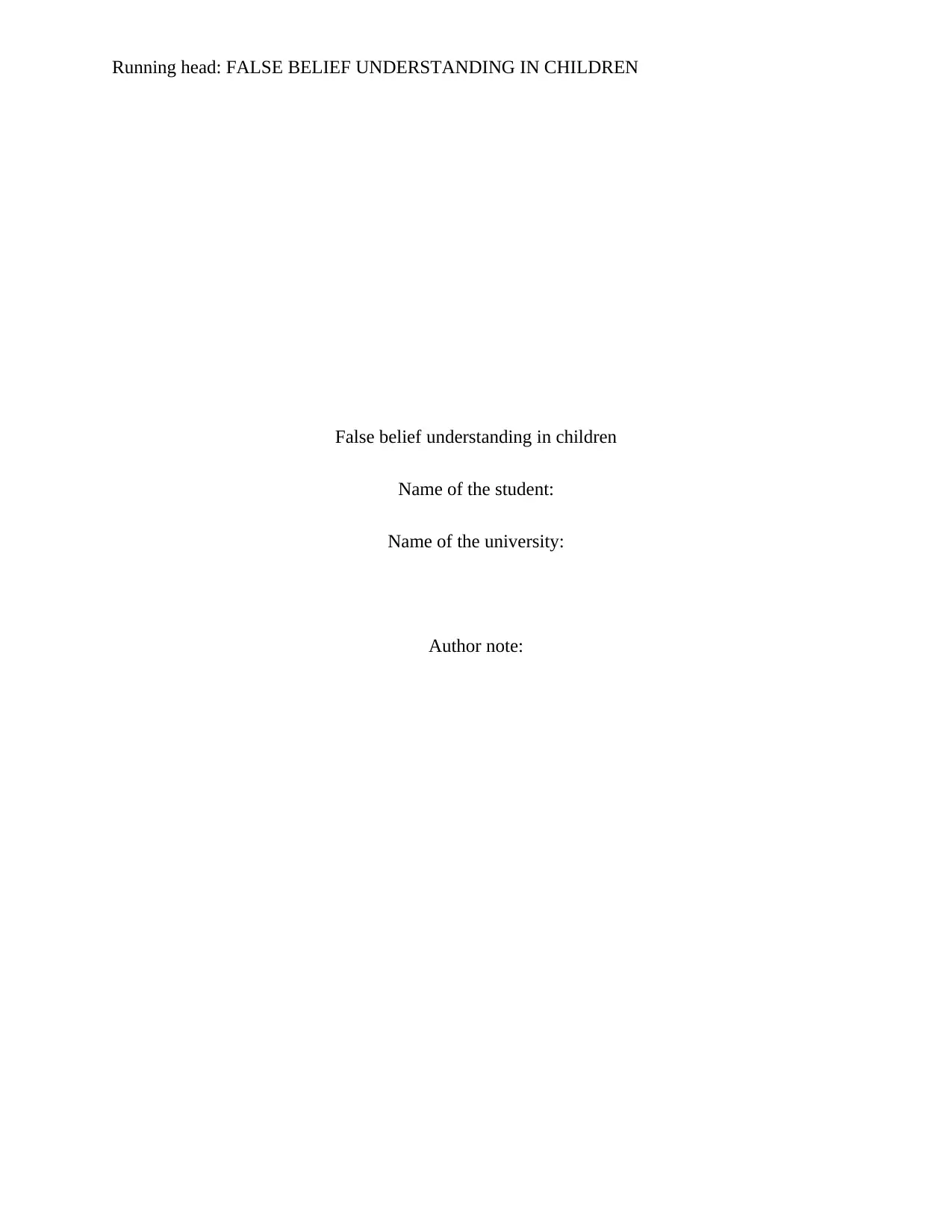
Running head: FALSE BELIEF UNDERSTANDING IN CHILDREN
False belief understanding in children
Name of the student:
Name of the university:
Author note:
False belief understanding in children
Name of the student:
Name of the university:
Author note:
Paraphrase This Document
Need a fresh take? Get an instant paraphrase of this document with our AI Paraphraser
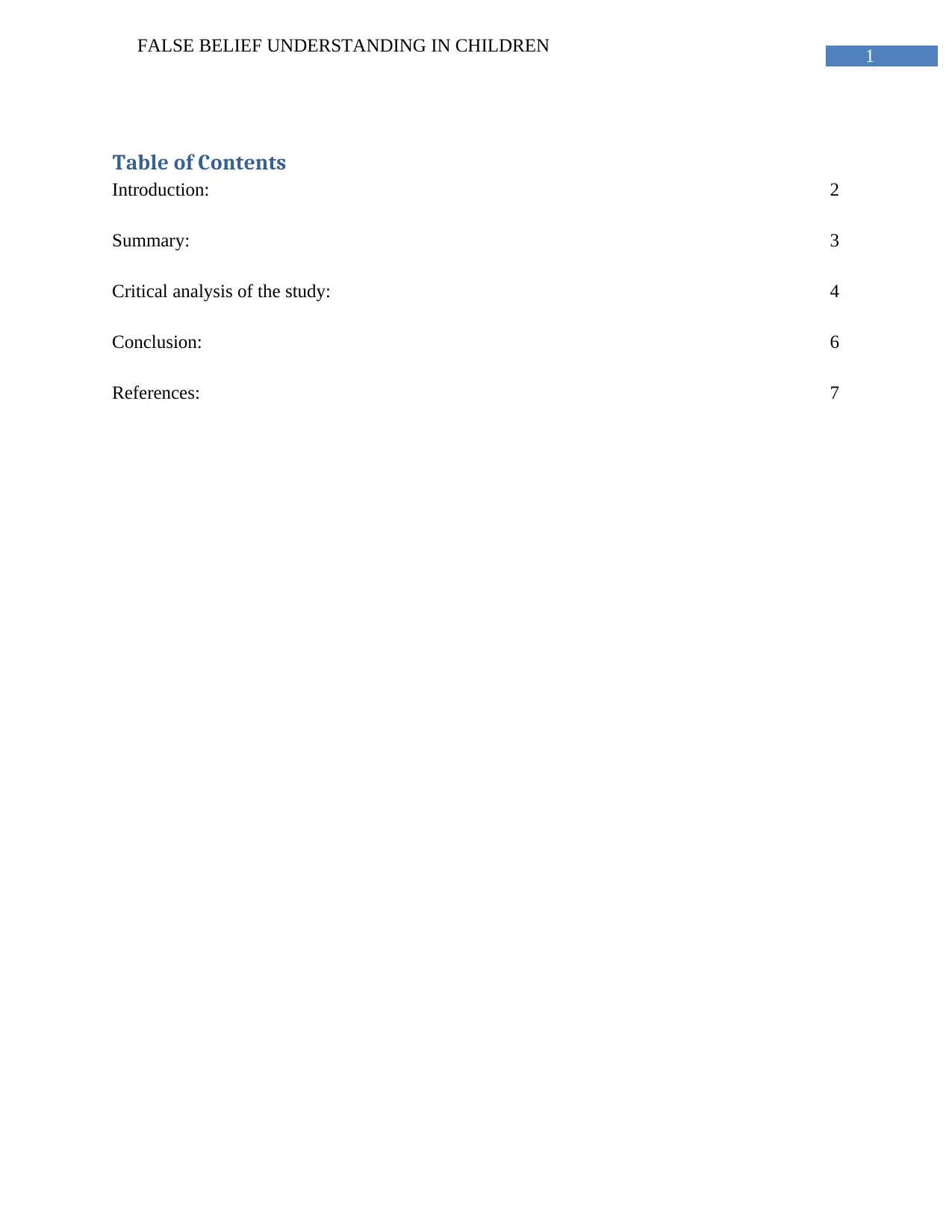
1
FALSE BELIEF UNDERSTANDING IN CHILDREN
Table of Contents
Introduction: 2
Summary: 3
Critical analysis of the study: 4
Conclusion: 6
References: 7
FALSE BELIEF UNDERSTANDING IN CHILDREN
Table of Contents
Introduction: 2
Summary: 3
Critical analysis of the study: 4
Conclusion: 6
References: 7
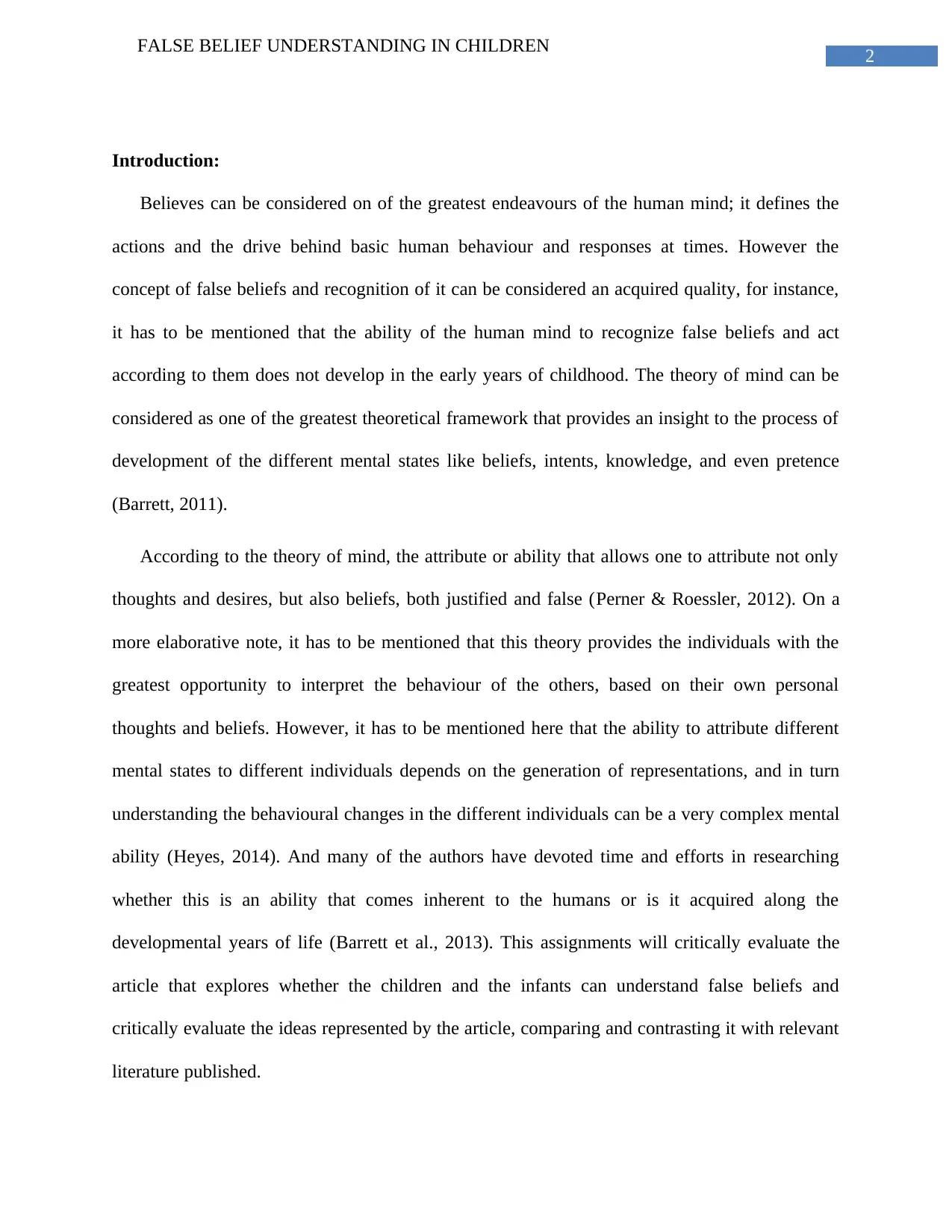
2
FALSE BELIEF UNDERSTANDING IN CHILDREN
Introduction:
Believes can be considered on of the greatest endeavours of the human mind; it defines the
actions and the drive behind basic human behaviour and responses at times. However the
concept of false beliefs and recognition of it can be considered an acquired quality, for instance,
it has to be mentioned that the ability of the human mind to recognize false beliefs and act
according to them does not develop in the early years of childhood. The theory of mind can be
considered as one of the greatest theoretical framework that provides an insight to the process of
development of the different mental states like beliefs, intents, knowledge, and even pretence
(Barrett, 2011).
According to the theory of mind, the attribute or ability that allows one to attribute not only
thoughts and desires, but also beliefs, both justified and false (Perner & Roessler, 2012). On a
more elaborative note, it has to be mentioned that this theory provides the individuals with the
greatest opportunity to interpret the behaviour of the others, based on their own personal
thoughts and beliefs. However, it has to be mentioned here that the ability to attribute different
mental states to different individuals depends on the generation of representations, and in turn
understanding the behavioural changes in the different individuals can be a very complex mental
ability (Heyes, 2014). And many of the authors have devoted time and efforts in researching
whether this is an ability that comes inherent to the humans or is it acquired along the
developmental years of life (Barrett et al., 2013). This assignments will critically evaluate the
article that explores whether the children and the infants can understand false beliefs and
critically evaluate the ideas represented by the article, comparing and contrasting it with relevant
literature published.
FALSE BELIEF UNDERSTANDING IN CHILDREN
Introduction:
Believes can be considered on of the greatest endeavours of the human mind; it defines the
actions and the drive behind basic human behaviour and responses at times. However the
concept of false beliefs and recognition of it can be considered an acquired quality, for instance,
it has to be mentioned that the ability of the human mind to recognize false beliefs and act
according to them does not develop in the early years of childhood. The theory of mind can be
considered as one of the greatest theoretical framework that provides an insight to the process of
development of the different mental states like beliefs, intents, knowledge, and even pretence
(Barrett, 2011).
According to the theory of mind, the attribute or ability that allows one to attribute not only
thoughts and desires, but also beliefs, both justified and false (Perner & Roessler, 2012). On a
more elaborative note, it has to be mentioned that this theory provides the individuals with the
greatest opportunity to interpret the behaviour of the others, based on their own personal
thoughts and beliefs. However, it has to be mentioned here that the ability to attribute different
mental states to different individuals depends on the generation of representations, and in turn
understanding the behavioural changes in the different individuals can be a very complex mental
ability (Heyes, 2014). And many of the authors have devoted time and efforts in researching
whether this is an ability that comes inherent to the humans or is it acquired along the
developmental years of life (Barrett et al., 2013). This assignments will critically evaluate the
article that explores whether the children and the infants can understand false beliefs and
critically evaluate the ideas represented by the article, comparing and contrasting it with relevant
literature published.
⊘ This is a preview!⊘
Do you want full access?
Subscribe today to unlock all pages.

Trusted by 1+ million students worldwide
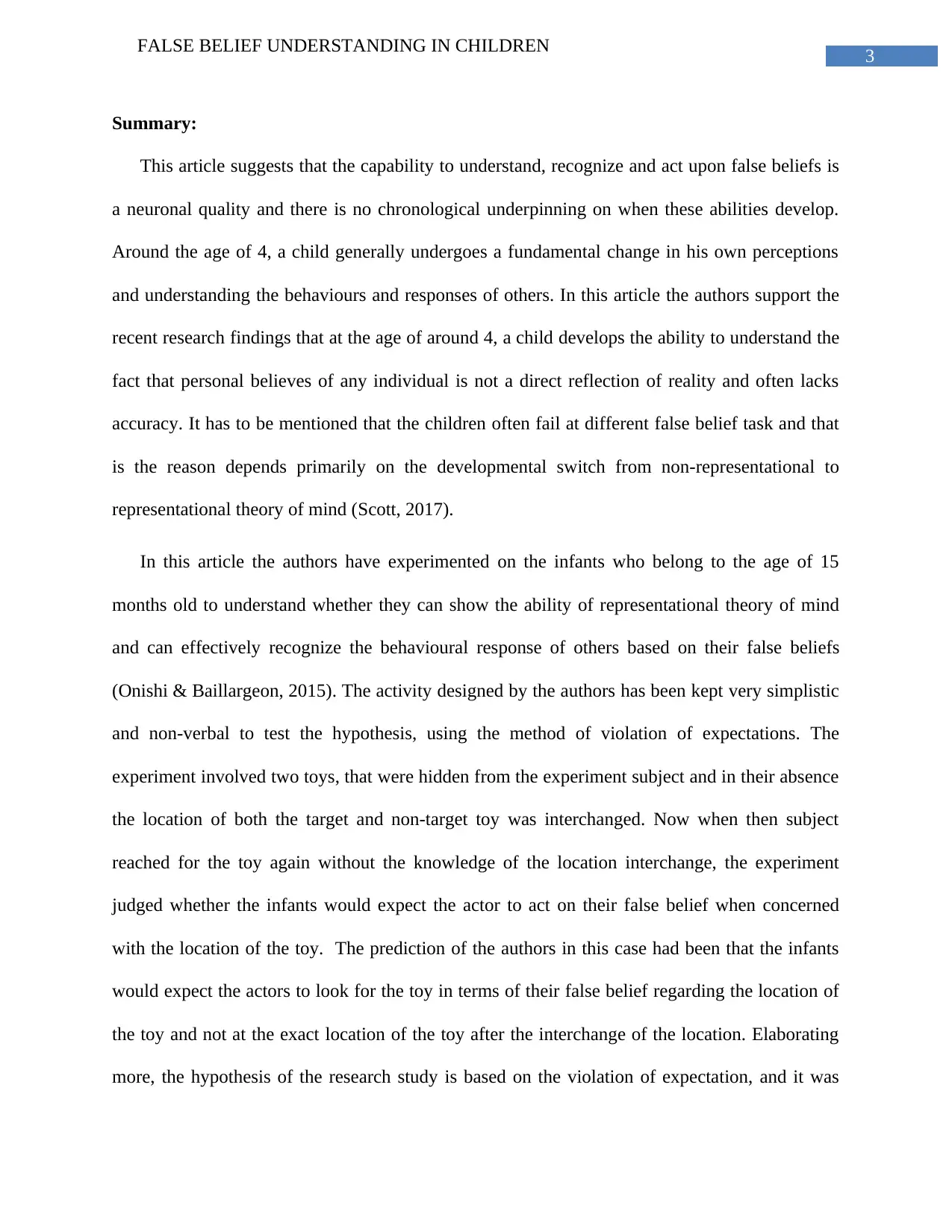
3
FALSE BELIEF UNDERSTANDING IN CHILDREN
Summary:
This article suggests that the capability to understand, recognize and act upon false beliefs is
a neuronal quality and there is no chronological underpinning on when these abilities develop.
Around the age of 4, a child generally undergoes a fundamental change in his own perceptions
and understanding the behaviours and responses of others. In this article the authors support the
recent research findings that at the age of around 4, a child develops the ability to understand the
fact that personal believes of any individual is not a direct reflection of reality and often lacks
accuracy. It has to be mentioned that the children often fail at different false belief task and that
is the reason depends primarily on the developmental switch from non-representational to
representational theory of mind (Scott, 2017).
In this article the authors have experimented on the infants who belong to the age of 15
months old to understand whether they can show the ability of representational theory of mind
and can effectively recognize the behavioural response of others based on their false beliefs
(Onishi & Baillargeon, 2015). The activity designed by the authors has been kept very simplistic
and non-verbal to test the hypothesis, using the method of violation of expectations. The
experiment involved two toys, that were hidden from the experiment subject and in their absence
the location of both the target and non-target toy was interchanged. Now when then subject
reached for the toy again without the knowledge of the location interchange, the experiment
judged whether the infants would expect the actor to act on their false belief when concerned
with the location of the toy. The prediction of the authors in this case had been that the infants
would expect the actors to look for the toy in terms of their false belief regarding the location of
the toy and not at the exact location of the toy after the interchange of the location. Elaborating
more, the hypothesis of the research study is based on the violation of expectation, and it was
FALSE BELIEF UNDERSTANDING IN CHILDREN
Summary:
This article suggests that the capability to understand, recognize and act upon false beliefs is
a neuronal quality and there is no chronological underpinning on when these abilities develop.
Around the age of 4, a child generally undergoes a fundamental change in his own perceptions
and understanding the behaviours and responses of others. In this article the authors support the
recent research findings that at the age of around 4, a child develops the ability to understand the
fact that personal believes of any individual is not a direct reflection of reality and often lacks
accuracy. It has to be mentioned that the children often fail at different false belief task and that
is the reason depends primarily on the developmental switch from non-representational to
representational theory of mind (Scott, 2017).
In this article the authors have experimented on the infants who belong to the age of 15
months old to understand whether they can show the ability of representational theory of mind
and can effectively recognize the behavioural response of others based on their false beliefs
(Onishi & Baillargeon, 2015). The activity designed by the authors has been kept very simplistic
and non-verbal to test the hypothesis, using the method of violation of expectations. The
experiment involved two toys, that were hidden from the experiment subject and in their absence
the location of both the target and non-target toy was interchanged. Now when then subject
reached for the toy again without the knowledge of the location interchange, the experiment
judged whether the infants would expect the actor to act on their false belief when concerned
with the location of the toy. The prediction of the authors in this case had been that the infants
would expect the actors to look for the toy in terms of their false belief regarding the location of
the toy and not at the exact location of the toy after the interchange of the location. Elaborating
more, the hypothesis of the research study is based on the violation of expectation, and it was
Paraphrase This Document
Need a fresh take? Get an instant paraphrase of this document with our AI Paraphraser
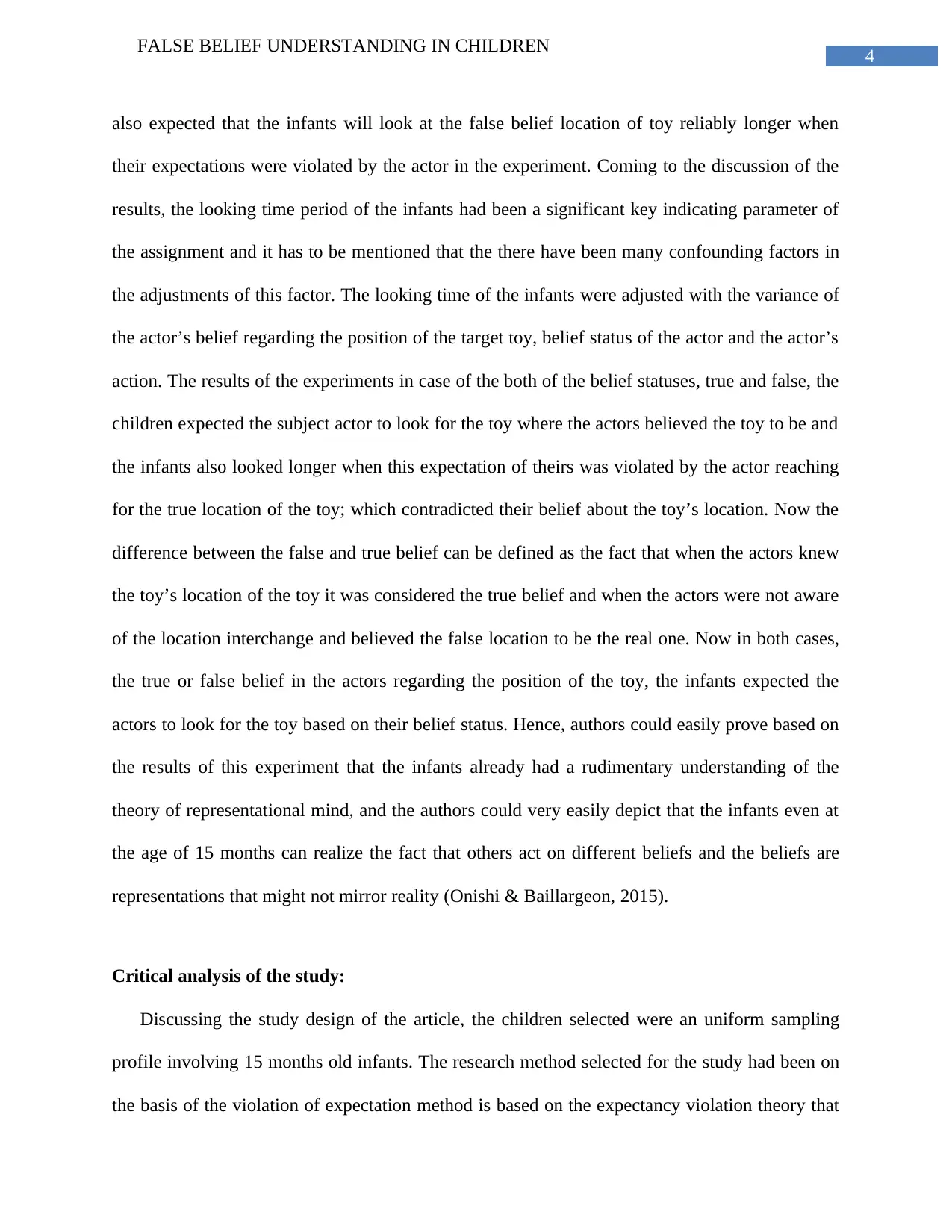
4
FALSE BELIEF UNDERSTANDING IN CHILDREN
also expected that the infants will look at the false belief location of toy reliably longer when
their expectations were violated by the actor in the experiment. Coming to the discussion of the
results, the looking time period of the infants had been a significant key indicating parameter of
the assignment and it has to be mentioned that the there have been many confounding factors in
the adjustments of this factor. The looking time of the infants were adjusted with the variance of
the actor’s belief regarding the position of the target toy, belief status of the actor and the actor’s
action. The results of the experiments in case of the both of the belief statuses, true and false, the
children expected the subject actor to look for the toy where the actors believed the toy to be and
the infants also looked longer when this expectation of theirs was violated by the actor reaching
for the true location of the toy; which contradicted their belief about the toy’s location. Now the
difference between the false and true belief can be defined as the fact that when the actors knew
the toy’s location of the toy it was considered the true belief and when the actors were not aware
of the location interchange and believed the false location to be the real one. Now in both cases,
the true or false belief in the actors regarding the position of the toy, the infants expected the
actors to look for the toy based on their belief status. Hence, authors could easily prove based on
the results of this experiment that the infants already had a rudimentary understanding of the
theory of representational mind, and the authors could very easily depict that the infants even at
the age of 15 months can realize the fact that others act on different beliefs and the beliefs are
representations that might not mirror reality (Onishi & Baillargeon, 2015).
Critical analysis of the study:
Discussing the study design of the article, the children selected were an uniform sampling
profile involving 15 months old infants. The research method selected for the study had been on
the basis of the violation of expectation method is based on the expectancy violation theory that
FALSE BELIEF UNDERSTANDING IN CHILDREN
also expected that the infants will look at the false belief location of toy reliably longer when
their expectations were violated by the actor in the experiment. Coming to the discussion of the
results, the looking time period of the infants had been a significant key indicating parameter of
the assignment and it has to be mentioned that the there have been many confounding factors in
the adjustments of this factor. The looking time of the infants were adjusted with the variance of
the actor’s belief regarding the position of the target toy, belief status of the actor and the actor’s
action. The results of the experiments in case of the both of the belief statuses, true and false, the
children expected the subject actor to look for the toy where the actors believed the toy to be and
the infants also looked longer when this expectation of theirs was violated by the actor reaching
for the true location of the toy; which contradicted their belief about the toy’s location. Now the
difference between the false and true belief can be defined as the fact that when the actors knew
the toy’s location of the toy it was considered the true belief and when the actors were not aware
of the location interchange and believed the false location to be the real one. Now in both cases,
the true or false belief in the actors regarding the position of the toy, the infants expected the
actors to look for the toy based on their belief status. Hence, authors could easily prove based on
the results of this experiment that the infants already had a rudimentary understanding of the
theory of representational mind, and the authors could very easily depict that the infants even at
the age of 15 months can realize the fact that others act on different beliefs and the beliefs are
representations that might not mirror reality (Onishi & Baillargeon, 2015).
Critical analysis of the study:
Discussing the study design of the article, the children selected were an uniform sampling
profile involving 15 months old infants. The research method selected for the study had been on
the basis of the violation of expectation method is based on the expectancy violation theory that
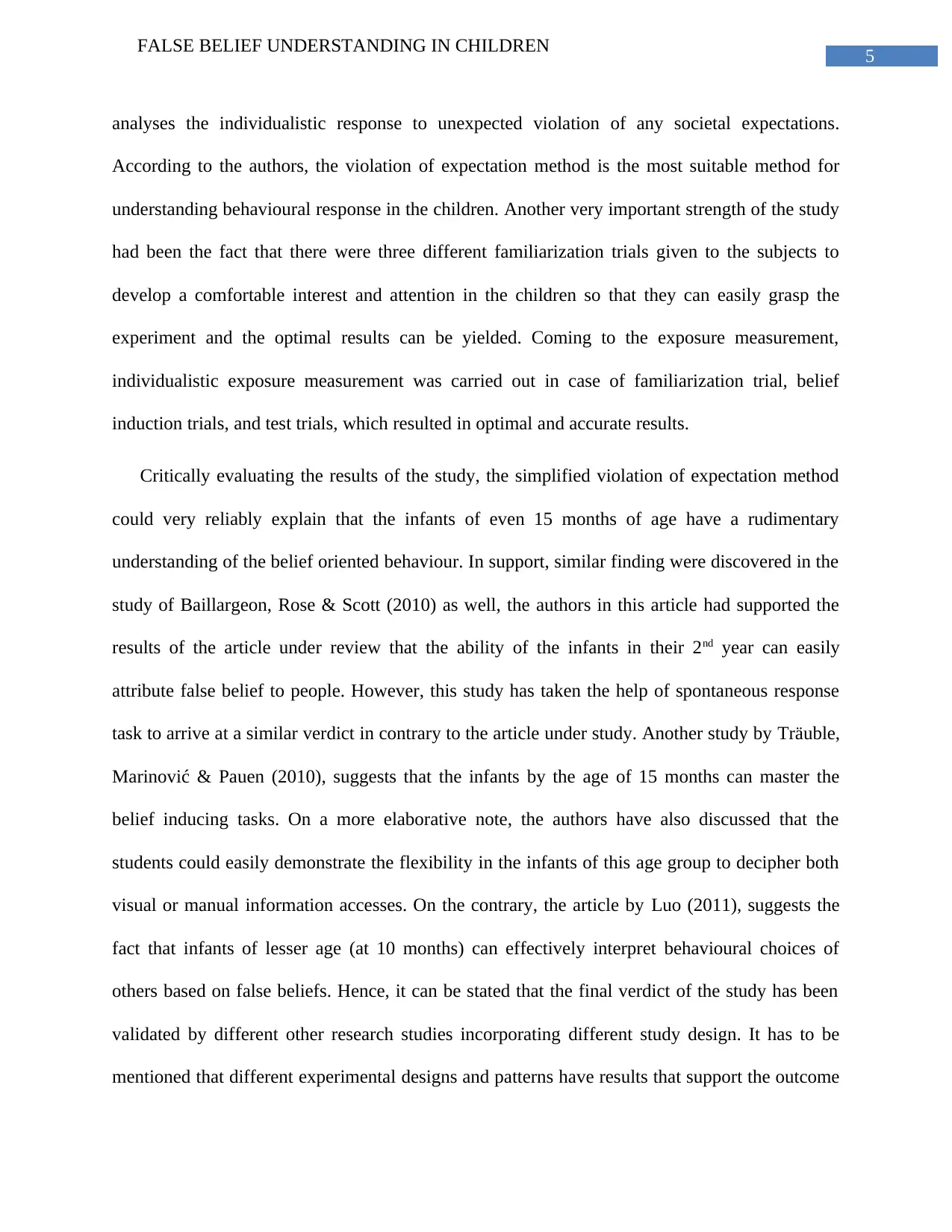
5
FALSE BELIEF UNDERSTANDING IN CHILDREN
analyses the individualistic response to unexpected violation of any societal expectations.
According to the authors, the violation of expectation method is the most suitable method for
understanding behavioural response in the children. Another very important strength of the study
had been the fact that there were three different familiarization trials given to the subjects to
develop a comfortable interest and attention in the children so that they can easily grasp the
experiment and the optimal results can be yielded. Coming to the exposure measurement,
individualistic exposure measurement was carried out in case of familiarization trial, belief
induction trials, and test trials, which resulted in optimal and accurate results.
Critically evaluating the results of the study, the simplified violation of expectation method
could very reliably explain that the infants of even 15 months of age have a rudimentary
understanding of the belief oriented behaviour. In support, similar finding were discovered in the
study of Baillargeon, Rose & Scott (2010) as well, the authors in this article had supported the
results of the article under review that the ability of the infants in their 2nd year can easily
attribute false belief to people. However, this study has taken the help of spontaneous response
task to arrive at a similar verdict in contrary to the article under study. Another study by Träuble,
Marinović & Pauen (2010), suggests that the infants by the age of 15 months can master the
belief inducing tasks. On a more elaborative note, the authors have also discussed that the
students could easily demonstrate the flexibility in the infants of this age group to decipher both
visual or manual information accesses. On the contrary, the article by Luo (2011), suggests the
fact that infants of lesser age (at 10 months) can effectively interpret behavioural choices of
others based on false beliefs. Hence, it can be stated that the final verdict of the study has been
validated by different other research studies incorporating different study design. It has to be
mentioned that different experimental designs and patterns have results that support the outcome
FALSE BELIEF UNDERSTANDING IN CHILDREN
analyses the individualistic response to unexpected violation of any societal expectations.
According to the authors, the violation of expectation method is the most suitable method for
understanding behavioural response in the children. Another very important strength of the study
had been the fact that there were three different familiarization trials given to the subjects to
develop a comfortable interest and attention in the children so that they can easily grasp the
experiment and the optimal results can be yielded. Coming to the exposure measurement,
individualistic exposure measurement was carried out in case of familiarization trial, belief
induction trials, and test trials, which resulted in optimal and accurate results.
Critically evaluating the results of the study, the simplified violation of expectation method
could very reliably explain that the infants of even 15 months of age have a rudimentary
understanding of the belief oriented behaviour. In support, similar finding were discovered in the
study of Baillargeon, Rose & Scott (2010) as well, the authors in this article had supported the
results of the article under review that the ability of the infants in their 2nd year can easily
attribute false belief to people. However, this study has taken the help of spontaneous response
task to arrive at a similar verdict in contrary to the article under study. Another study by Träuble,
Marinović & Pauen (2010), suggests that the infants by the age of 15 months can master the
belief inducing tasks. On a more elaborative note, the authors have also discussed that the
students could easily demonstrate the flexibility in the infants of this age group to decipher both
visual or manual information accesses. On the contrary, the article by Luo (2011), suggests the
fact that infants of lesser age (at 10 months) can effectively interpret behavioural choices of
others based on false beliefs. Hence, it can be stated that the final verdict of the study has been
validated by different other research studies incorporating different study design. It has to be
mentioned that different experimental designs and patterns have results that support the outcome
⊘ This is a preview!⊘
Do you want full access?
Subscribe today to unlock all pages.

Trusted by 1+ million students worldwide
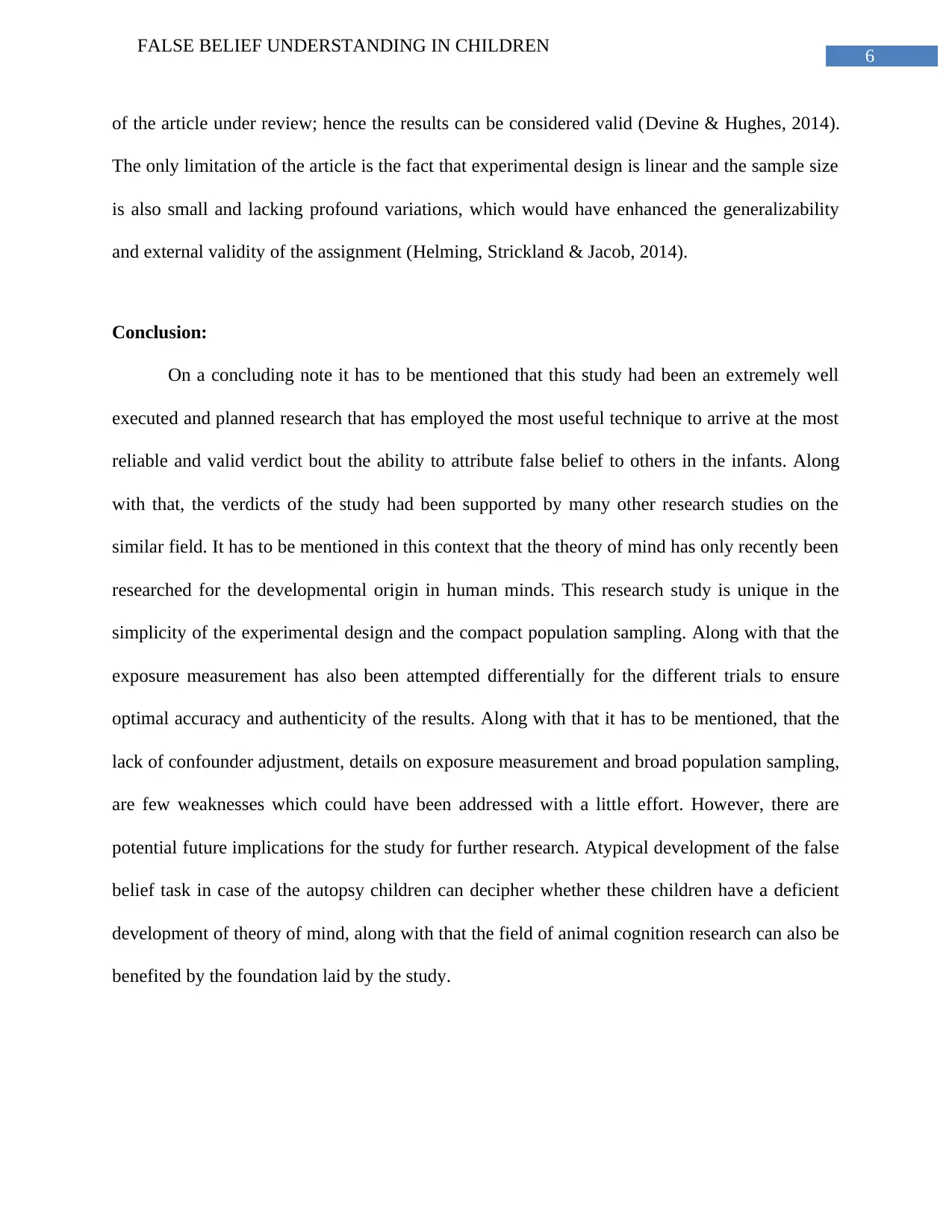
6
FALSE BELIEF UNDERSTANDING IN CHILDREN
of the article under review; hence the results can be considered valid (Devine & Hughes, 2014).
The only limitation of the article is the fact that experimental design is linear and the sample size
is also small and lacking profound variations, which would have enhanced the generalizability
and external validity of the assignment (Helming, Strickland & Jacob, 2014).
Conclusion:
On a concluding note it has to be mentioned that this study had been an extremely well
executed and planned research that has employed the most useful technique to arrive at the most
reliable and valid verdict bout the ability to attribute false belief to others in the infants. Along
with that, the verdicts of the study had been supported by many other research studies on the
similar field. It has to be mentioned in this context that the theory of mind has only recently been
researched for the developmental origin in human minds. This research study is unique in the
simplicity of the experimental design and the compact population sampling. Along with that the
exposure measurement has also been attempted differentially for the different trials to ensure
optimal accuracy and authenticity of the results. Along with that it has to be mentioned, that the
lack of confounder adjustment, details on exposure measurement and broad population sampling,
are few weaknesses which could have been addressed with a little effort. However, there are
potential future implications for the study for further research. Atypical development of the false
belief task in case of the autopsy children can decipher whether these children have a deficient
development of theory of mind, along with that the field of animal cognition research can also be
benefited by the foundation laid by the study.
FALSE BELIEF UNDERSTANDING IN CHILDREN
of the article under review; hence the results can be considered valid (Devine & Hughes, 2014).
The only limitation of the article is the fact that experimental design is linear and the sample size
is also small and lacking profound variations, which would have enhanced the generalizability
and external validity of the assignment (Helming, Strickland & Jacob, 2014).
Conclusion:
On a concluding note it has to be mentioned that this study had been an extremely well
executed and planned research that has employed the most useful technique to arrive at the most
reliable and valid verdict bout the ability to attribute false belief to others in the infants. Along
with that, the verdicts of the study had been supported by many other research studies on the
similar field. It has to be mentioned in this context that the theory of mind has only recently been
researched for the developmental origin in human minds. This research study is unique in the
simplicity of the experimental design and the compact population sampling. Along with that the
exposure measurement has also been attempted differentially for the different trials to ensure
optimal accuracy and authenticity of the results. Along with that it has to be mentioned, that the
lack of confounder adjustment, details on exposure measurement and broad population sampling,
are few weaknesses which could have been addressed with a little effort. However, there are
potential future implications for the study for further research. Atypical development of the false
belief task in case of the autopsy children can decipher whether these children have a deficient
development of theory of mind, along with that the field of animal cognition research can also be
benefited by the foundation laid by the study.
Paraphrase This Document
Need a fresh take? Get an instant paraphrase of this document with our AI Paraphraser
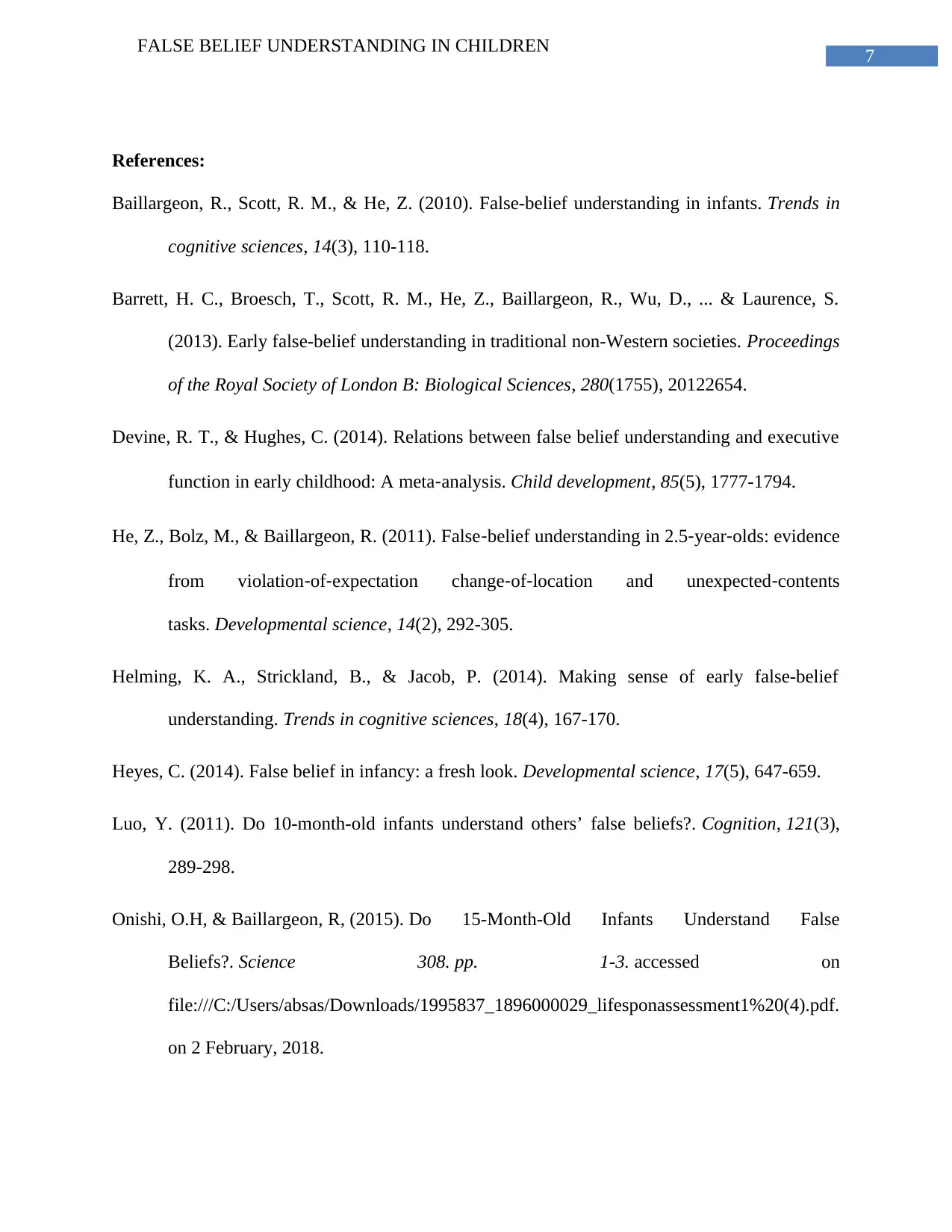
7
FALSE BELIEF UNDERSTANDING IN CHILDREN
References:
Baillargeon, R., Scott, R. M., & He, Z. (2010). False-belief understanding in infants. Trends in
cognitive sciences, 14(3), 110-118.
Barrett, H. C., Broesch, T., Scott, R. M., He, Z., Baillargeon, R., Wu, D., ... & Laurence, S.
(2013). Early false-belief understanding in traditional non-Western societies. Proceedings
of the Royal Society of London B: Biological Sciences, 280(1755), 20122654.
Devine, R. T., & Hughes, C. (2014). Relations between false belief understanding and executive
function in early childhood: A meta‐analysis. Child development, 85(5), 1777-1794.
He, Z., Bolz, M., & Baillargeon, R. (2011). False‐belief understanding in 2.5‐year‐olds: evidence
from violation‐of‐expectation change‐of‐location and unexpected‐contents
tasks. Developmental science, 14(2), 292-305.
Helming, K. A., Strickland, B., & Jacob, P. (2014). Making sense of early false-belief
understanding. Trends in cognitive sciences, 18(4), 167-170.
Heyes, C. (2014). False belief in infancy: a fresh look. Developmental science, 17(5), 647-659.
Luo, Y. (2011). Do 10-month-old infants understand others’ false beliefs?. Cognition, 121(3),
289-298.
Onishi, O.H, & Baillargeon, R, (2015). Do 15-Month-Old Infants Understand False
Beliefs?. Science 308. pp. 1-3. accessed on
file:///C:/Users/absas/Downloads/1995837_1896000029_lifesponassessment1%20(4).pdf.
on 2 February, 2018.
FALSE BELIEF UNDERSTANDING IN CHILDREN
References:
Baillargeon, R., Scott, R. M., & He, Z. (2010). False-belief understanding in infants. Trends in
cognitive sciences, 14(3), 110-118.
Barrett, H. C., Broesch, T., Scott, R. M., He, Z., Baillargeon, R., Wu, D., ... & Laurence, S.
(2013). Early false-belief understanding in traditional non-Western societies. Proceedings
of the Royal Society of London B: Biological Sciences, 280(1755), 20122654.
Devine, R. T., & Hughes, C. (2014). Relations between false belief understanding and executive
function in early childhood: A meta‐analysis. Child development, 85(5), 1777-1794.
He, Z., Bolz, M., & Baillargeon, R. (2011). False‐belief understanding in 2.5‐year‐olds: evidence
from violation‐of‐expectation change‐of‐location and unexpected‐contents
tasks. Developmental science, 14(2), 292-305.
Helming, K. A., Strickland, B., & Jacob, P. (2014). Making sense of early false-belief
understanding. Trends in cognitive sciences, 18(4), 167-170.
Heyes, C. (2014). False belief in infancy: a fresh look. Developmental science, 17(5), 647-659.
Luo, Y. (2011). Do 10-month-old infants understand others’ false beliefs?. Cognition, 121(3),
289-298.
Onishi, O.H, & Baillargeon, R, (2015). Do 15-Month-Old Infants Understand False
Beliefs?. Science 308. pp. 1-3. accessed on
file:///C:/Users/absas/Downloads/1995837_1896000029_lifesponassessment1%20(4).pdf.
on 2 February, 2018.
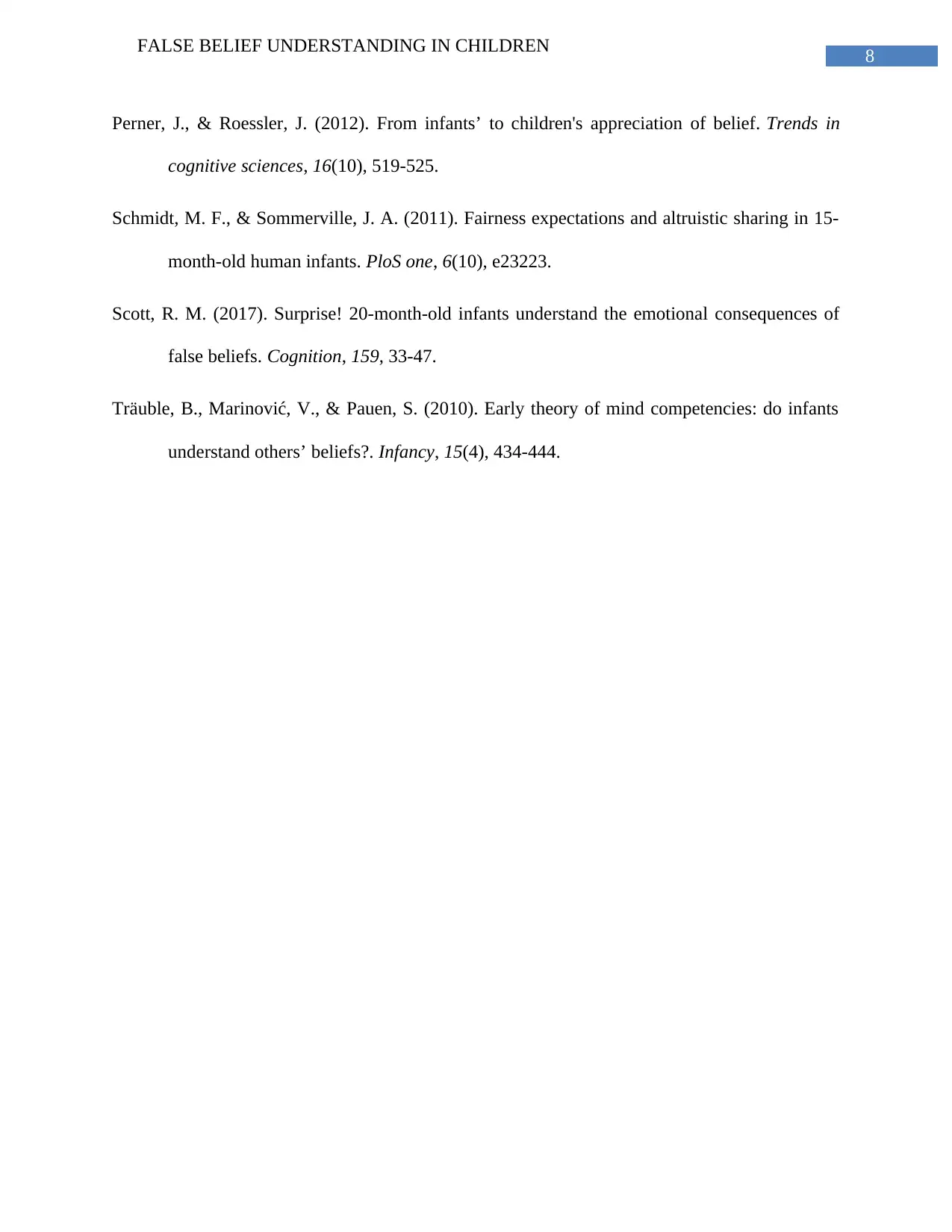
8
FALSE BELIEF UNDERSTANDING IN CHILDREN
Perner, J., & Roessler, J. (2012). From infants’ to children's appreciation of belief. Trends in
cognitive sciences, 16(10), 519-525.
Schmidt, M. F., & Sommerville, J. A. (2011). Fairness expectations and altruistic sharing in 15-
month-old human infants. PloS one, 6(10), e23223.
Scott, R. M. (2017). Surprise! 20-month-old infants understand the emotional consequences of
false beliefs. Cognition, 159, 33-47.
Träuble, B., Marinović, V., & Pauen, S. (2010). Early theory of mind competencies: do infants
understand others’ beliefs?. Infancy, 15(4), 434-444.
FALSE BELIEF UNDERSTANDING IN CHILDREN
Perner, J., & Roessler, J. (2012). From infants’ to children's appreciation of belief. Trends in
cognitive sciences, 16(10), 519-525.
Schmidt, M. F., & Sommerville, J. A. (2011). Fairness expectations and altruistic sharing in 15-
month-old human infants. PloS one, 6(10), e23223.
Scott, R. M. (2017). Surprise! 20-month-old infants understand the emotional consequences of
false beliefs. Cognition, 159, 33-47.
Träuble, B., Marinović, V., & Pauen, S. (2010). Early theory of mind competencies: do infants
understand others’ beliefs?. Infancy, 15(4), 434-444.
⊘ This is a preview!⊘
Do you want full access?
Subscribe today to unlock all pages.

Trusted by 1+ million students worldwide
1 out of 9
Related Documents
Your All-in-One AI-Powered Toolkit for Academic Success.
+13062052269
info@desklib.com
Available 24*7 on WhatsApp / Email
![[object Object]](/_next/static/media/star-bottom.7253800d.svg)
Unlock your academic potential
Copyright © 2020–2025 A2Z Services. All Rights Reserved. Developed and managed by ZUCOL.





